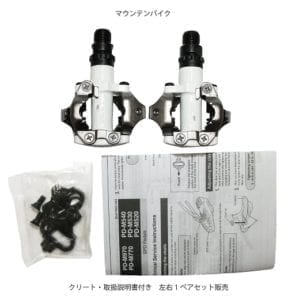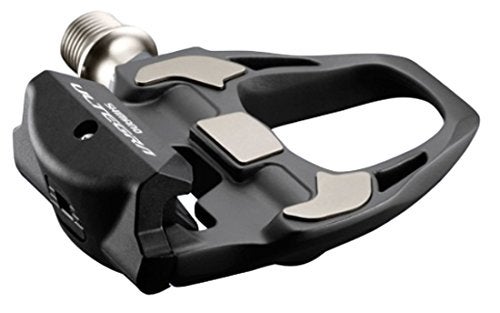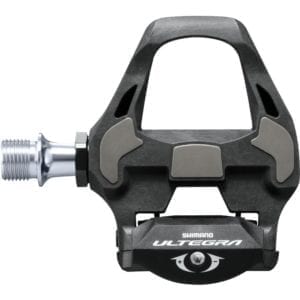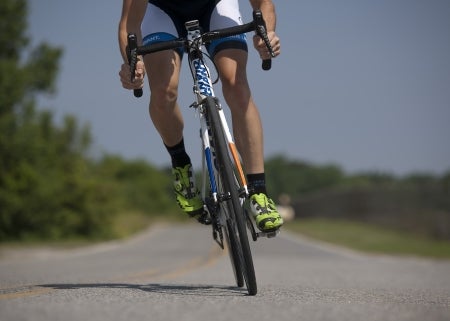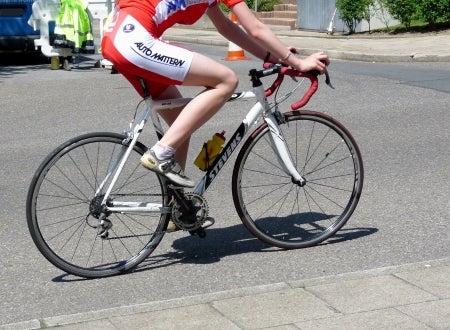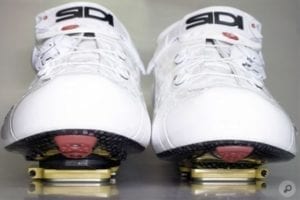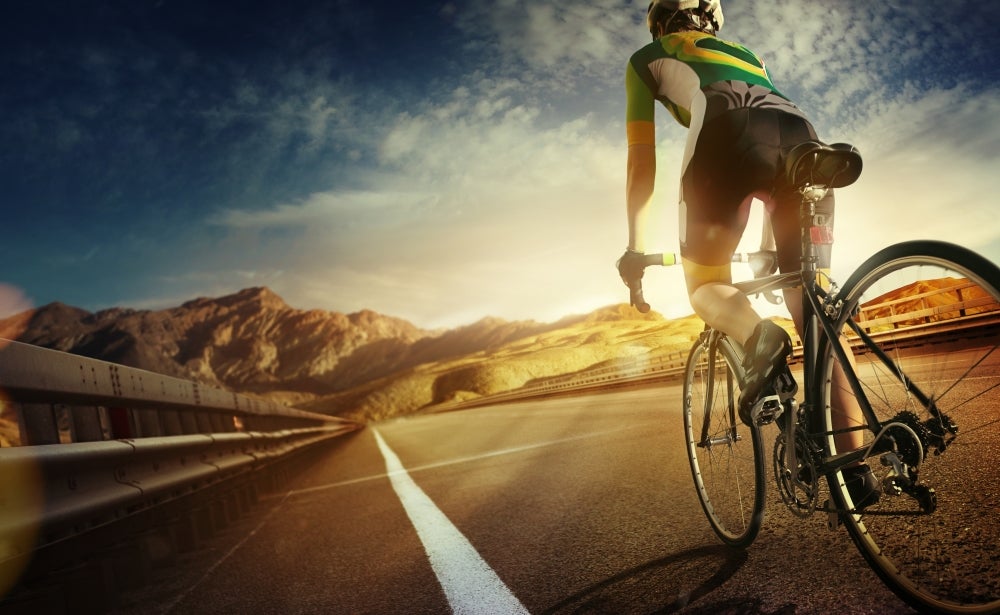
Our Editors independently research, test, and rate what we feel are the best products. We use affiliate links and may receive a small commission on purchases.
Have a look at our recommendations for the top-rated and best road bike pedals. Also see our buying guide, How To Choose The Best Road Bike Pedals For You.
If you are new to clipless pedals you will also need to invest in a pair of compatible shoes. We look at the latest road biking shoes at Best Road Bike Shoes. And you may also be interested to see the Amazon Best Sellers.
The Best Road Bike Pedals
Also see: Road Bike Pedals Comparison Table
Quick Answer: Best-Rated Road Bike Pedals
Road Bike Pedals Reviews
#1 Shimano PD-M520
![]()
Although technically listed by Shimano as a mountain biking pedal, these are a great choice for road biking too, especially if you are new to clipless pedals. Very simple, durable design – bulletproof.
Despite the low price, the PD-M520 Shimano road pedals are constructed well and are very durable. The body is made from alloy while the mechanism and axle are steel. When the bearings wear out, you can replace them easily with the help of a cheap locking tool. The tension can be adjusted to suit your preference.
They may not be the lightest pedals available but if you are not a racer or want to use the same pedals on other bikes (CX, gravel, mountain bike) then you can get several pairs of these for less than a single pair of high end pedals.
Having the same engagement system on all of your bikes is a big plus so you never end up flapping your foot around having forgotten which pedal you are trying to clip into.
The Shimano PD-M520 is a straightforward, super-durable design and for this reason we generally recommend it as the best clipless pedals for beginners.
#2 Look Keo 2 Max Blade 12
These Look Keo pedals are a mix of two previous Look pedal designs. Instead of a carbon spring blade used in other more expensive models, the Max Blade 12 has a glass-fiber composite blade. There is no way to adjust the tension once the blade is installed but you can choose between two blades with either 8Nm or 12Nm torque.
The included cleats have 4.5 degrees of float and you can purchase zero degree or 9 degree cleats if you want.
The wide platform surrounds a chromoly axle. A wider platform means power is transferred over a bigger area and the load spread over your foot. This is certainly the case with with Max Blade 12 and your foot feels incredibly secure when clipped in. You can sprint in confidence with these cycle pedals, but the release tension does feel quite tough.
The platform itself is covered with a stainless steel plate to maximise the life of the pedals. Once this has been worn away you will need to buy new pedals, but it will take you a long time and a huge number of rides for that to happen.
The bearings are not serviceable so it is feasible that the bearings will be worn out before you need to replace the plate anyway. Out of the box these pedals sit with the rear pointing down, which helps greatly when clipping in.
The Max Blade 12 pedals are a great entry into the world of clipless road pedals.
#3 Shimano Ultegra SPD-SL R8000
The SPD-SL Shimano road pedals are time tested and very reliable pedals. This model has always been favored as a pedal that needs little maintenance and the R8000 version makes some improvements over the old design.
The wide platform provides a solid connection with the three bolt cleats. As standard the pedals come with cleats that can be adjusted +/- 3 degrees. Other cleats are available that have zero float or 1 degree.
Shimano have kept the stack height as low as possible to keep you low on the bike and confident through corners.
Overall the pedals are slim so you do not have to worry about clearance and the solid construction means they hold up to being smacked into the road on the occasions when you shouldn’t have been pedaling through a corner but did anyway.
Should you use these pedals a huge amount, the steel contact plate can be replaced but you will need to use them for many, many, many rides before this happens.
The R8000 version has a carbon body and a stainless steel spindle and has a slightly longer axle to prevent heel rub. The stack height has also been reduced slightly in comparison to older models.
The one drawback is that there is a relatively long break in time. You will need to use them for a quite a few rides before the rear drops down by itself to allow easy entry.
For intermediate road riding and racing, the SPD-Sl R8000 pedals are perfect. If you want a pedal with the exact same feel but is lighter and a bit more expensive, have a look at the Dura-Ace pedals.
#4 Time Xpresso 15
If it is lightweight and fast pedals for racing you want, take a look at the Time Xpresso 15. They weigh just 140g (the pair) thanks to the carbon body and hollow titanium axle. They are even help you ride faster thanks to the ceramic bearings, although you are unlikely to actually notice this and the gain is definitely marginal.
The design of the mechanism allows you to clip in very easily as it remains partially open until the cleat arrives. Once you push the cleat into it, the mechanism closes and holds on solidly by means of a carbon strip (as opposed to a metal spring found in other pedals). The strength of the mechanism means that it is impossible to accidentally pull your foot out but when you do want to release, just a small twist to the side will open the mechanism.
The resistance of the strip can be adjusted using a screwdriver and the pedals have a fixed 5 degrees of float. A nice feature of the Xpresso 15 pedals is that you can customise the Q Factor (distance between your feet, or the distance between the crank and cleat) by swapping the cleats around. The cleats themselves do tend to wear out quite fast so try to avoid walking around too much in them.
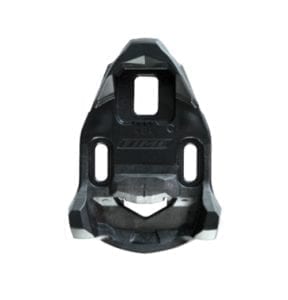
Ceramic bearings are apparently much more durable than others and the Xpresso 15 bearings are technically serviceable but if you attempt this yourself, you will void the two year warranty.
Lightweight, durable and easy to click into, the Xpresso 15 pedals are a pricy but good value pedal for serious riding or racing.
#5 Speedplay Zero
Speedplay turned the clipless idea literally upside down by integrating the mechanism into the part that screws into the shoe. As a result the pedal is dual-sided like SPD pedals.
You do have to be careful where you tread when off the bike though, as the mechanism can easily get clogged up with mud or dirt. If this happens, you will have to remove it before being able to clip in. For usual racing conditions it is unlikely that you will have a problem.
Speedplay have managed to keep the stack height lower than most other pedals. 3mm is added if you have a three bolt shoe and need to use the adapter (Speedplay Zero pedals use four bolts) but even with this adapter the stack height remains low.
The whole pedal has a low profile for maximum cornering clearance. The float is adjustable between zero and a huge 15 degrees. For this reason, the Zeros are popular among cyclists with knee problems, as the massive float available can relieve a lot of pressure.
While such a big amount of float might help your knees, it does feel a bit disconnected when sprinting as your foot can flop around a bit. Adjusting the float is achieved by tightening or loosening two screws found on the cleat.
Each screw controls the float on the “heel in” or “heel out” side. The crosshead screws are tiny and are not particularly easy to turn. On top of that they are prone to picking up lots of road grime and will seize up if you do not keep them clean and greased.
Engagement and release is on the stronger side compared to other pedals, especially during the first few rides as they break in. Once you are in, you are staying there until you deliberately want to unclip, which is great for racing.
In terms of maintenance, you will need to regrease the bearings occasionally as grease gets forced out of them during use. Speedplay Zero is a sophisticated, verstatile system, and as such may not be the best road bike pedals for beginners.
There are a few different models of the Zero pedal available, which come at different weight and price points due to the materials used.
The chromoly version is the cheapest and heaviest, followed by the stainless steel version.
If you like spending lots of money to get the lightest version of an already light pedal, then there is a titanium version for you.
Road Bike Pedals Comparison Table
| Best Road Bike Pedals | Construction | Weight | Special Features | Customer Ratings | |
|---|---|---|---|---|---|
| Shimano PD-M520 | Aluminum body ; chrome-moly spindle | 380 grams (pair) | Adjustable clip release tension | 4.7 / 5.0 Stars | |
| Look Keo 2 Max Pedal | Composite polyamide (graphite) body ; stainless steel wear plate | 260 grams (pair) | Oversized axles w/ dual seals makes this pedal extra durable | 4.4 / 5.0 Stars | |
| Shimano Ultegra SPD-SL R8000 | Injection-molded carbon composite body | 248 grams (pair) | Segmented top plate and a -0.7mm lower stack height | 4.8 / 5.0 Stars |
|
| Time Xpresso 15 | Carbon pedal body | 133 grams (pair) | 13.5mm stack height, Adjustable +/- 2.6 mm q-factor | 3.2 / 5.0 Stars |
|
| Speedplay Zero | Speedplay Zero S/S Pedal Black w/Walk Cleat | 498 grams | N/A | 3.4 / 5.0 Stars |
How to Choose the Best Road Bike Pedals For You
Clipless pedals will make a huge difference in your road bike experience. Not just quality, but also fit and function determine which are the best road bike pedals for you. Your pedals will have a big influence on performance, comfort and fatigue.
It is important that you understand the technical characteristics of clipless road bike pedals types before making your purchase decision. Pedals and the connection between your road bike pedals and shoes play a crucial role in how much power gets transferred from your muscles through the drivetrain to the wheels.
A pair of flat pedals such as found on “normal” bicycles is not an efficient pedaling platform because your foot is not held in place. When cycling developed from a form of transport to a sport, it was soon realized that a pedal holding the shoe creates a more powerful pedal stroke.
Road bike pedals used to have “bike clips” for the toe end of shoes, and straps to hold everything where it is. Once strapped in, you were stuck in there until you released the straps. This meant no stopping or high-risk track stands.
Eventually, clipless pedals were invented. The toe clips and straps were abandoned in favor of a cleat attached to the sole of the shoe that locks into a mechanism on the pedal. Twisting the foot sideways releases the hold, allowing you to put your foot down.
The name clipless can be somewhat confusing as you do still clip in, just not with the same clips as before. The inventors of the new system wanted to distance themselves from the old system and hence the name.
Two or Three Bolts
There are three types of clipless pedals systems. The original is the three bolt design. A cleat bolts onto the flat sole of the shoe. The cleat sticks out from the bottom of the shoe, making it hard to walk (stiff-soled cycling shoes are also hard to walk in without the cleat) but the wide connection area to the shoe produces efficient pedaling.
Even with the best road bike pedals on the market, clipping in requires a great deal of precision and practice for the first time user.
After a while, the two bolt design was introduced, with a much smaller cleat that bolts into the a recess in the sole and the pedal can be entered from either side. As the cleat remains in the recess, these shoes are easier to walk around in and the system is easier to clip into.
The shoes for two bolt clipless pedals are heavier than three bolt because shoe material needs to surround the recess. There is also a four bolt system used by Speedplay Inc.
Float
The first clipless pedals caused some riders a lot of knee pain because their feet were held rigidly in place. Designers worked their magic on subsequent models to allow the foot to move a little during the pedal stroke, which relieved knee pressure. This movement is called float and is found on modern clipless pedals.
Most models have adjustable float to get the pedals set up as comfortably as possible. The more float a pedal has, the more you have to twist your foot to release. Some pedals still have “zero-float” and will release your foot with the smallest of twists.
Release Tension
On top of the angle needed to release the cleat, you can usually adjust the tension that holds the cleat. Less tension means you need less force to release and it is easier to clip in. This is a great way to start for clipless beginners to avoid traffic light accidents. As you get more confident, you can increase the tension and enjoy a more secure connection with less chance of accidental release.
Stack Height
The closer your foot is to the pedal axle, the more efficient your pedal stroke will be. Obviously, adding a cleat to the bottom of your shoe will move your foot further away from the axle so look for as small a stack height as possible.
Thanks for reading The 5 Best Road Bike Pedals – 2019. We hope that this article was a helpful to you in your search for the best pedals for road biking to meet your specific needs. Also see these informative articles, Top 10 Road Biking Routes in the United States and How To Get Started Road Biking – A Beginner’s Guide.
MORE BIKE GEAR ROAD BIKE SHOES | ROAD BIKE PEDALS | CYCLING SHORTS | ROAD BIKE JERSEYS | ROAD BIKE WHEELS | ROAD BIKES UNDER $500 | ROAD BIKES UNDER $1000 | ELECTRIC BIKE CONVERSION KITS | ELECTRIC FOLDING BIKES | E-BIKE BATTERIES | CRUISER BIKES | BEACH CRUISERS | BALANCE BIKES | BIKE TRAVEL BAGS | ROAD BIKE HELMETS
How We Researched
To come up with the top road cycling pedals, we researched a variety of sources for reviews such as CompetitiveCyclist, JensenUSA, REI, EVO along with our own personal experience.
We also consulted online magazines for product research and reviews to get as much unbiased information as we could. To help weed out fake reviews we used Fakespot.com to make sure we only looked at genuine reviews.
With so much quality gear available, we had to narrow it down based on what we felt were the best options for the price. The staff authors have a wide and varied background in road cycling, racing and bike packing.
The authors have decades of experience in cycling and eager to share their knowledge with readers.
To help narrow down the selection we used personal experiences along with recommendations from fellow cyclists, bloggers and bike shops.
After extensive research, we came up with our list to help you choose the right one for you.

